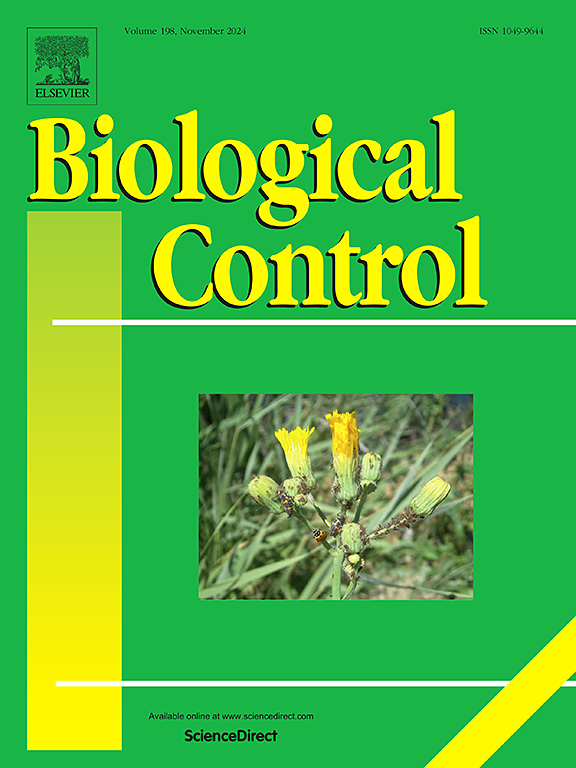Antifungal activity of Xenorhabdus and Photorhabdus against aerial and soilborne grapevine pathogens: varying efficiencies and non-target effects
IF 3.4
2区 农林科学
Q2 BIOTECHNOLOGY & APPLIED MICROBIOLOGY
引用次数: 0
Abstract
The extensive use of fungicides raises significant environmental and health concerns, including biodiversity loss and risks to agricultural workers, while the emergence of new fungal diseases exacerbates reliance on these chemical agents. Recent research highlights the potential of Xenorhabdus and Photorhabdus, symbiotic bacteria of entomopathogenic nematodes (EPN), as alternative biocontrol agents against soilborne and aerial fungal pathogens. This study aimed to evaluate the efficacy of EPN-symbiotic bacteria and their by-products against selected fungi and their potential non-target effects on biocontrol agents used in vineyards as a model agroecosystem. Specifically, this study investigated (i) the antifungal effect of Xenorhabdus nematophila cultured in three different nutrient media (Tryptone Soya Broth- TSB-, Nutrient Broth –NB, and Luria-Bertani –LB-) and under varying fermentation durations (3 and 10 days) against Botrytis cinerea; (ii) the antifungal activity of X. nematophila and Photorhabdus laumondii subsp. laumondii against the soilborne pathogen Armillaria mellea; and (iii) the antibacterial activity of X. nematophila, X. bovienii, P. laumondii subsp. laumondii and Photorhabdus luminescens subsp. kayaii by-products against Bacillus spp., including strains used as commercial biocontrol products. Our results demonstrated that X. nematophila cultured in TSB and NB produced the highest inhibition of B. cinerea, with inhibitory effects ranging from 63.5 % to 74.3 %, depending significantly on the fermentation duration. For A. mellea, both cell-free supernatants (CFS) and unfiltered ferments (UFs) from X. nematophila and P. laumondii subsp. laumondii significantly reduced colony numbers and colonized areas, with UFs exhibiting superior efficacy. Non-target effect assays revealed selective antibacterial activity, with significant inhibition observed only against Bacillus thuringiensis var. kurstaki ABTS-351, while no effect was detected against B. thuringiensis PB-54 or B. amyloliquefaciens QST-713. These findings highlight the dual potential of Xenorhabdus and Photorhabdus bacteria as biocontrol agents for fungal pathogens and for promoting selective microbial interactions. However, further studies are needed to optimize their efficacy and assess potential non-target effects in integrated pest management in vineyards and other agroecosystems.

Xenorhabdus和光habdus对空气和土壤传播的葡萄藤病原体的抗真菌活性:不同的效率和非目标效应
杀菌剂的广泛使用引起了重大的环境和健康问题,包括生物多样性的丧失和农业工人的风险,而新的真菌疾病的出现加剧了对这些化学剂的依赖。最近的研究强调了昆虫病原线虫(EPN)的共生细菌Xenorhabdus和光habdus作为土壤和空气真菌病原体的替代生物防治剂的潜力。本研究旨在评估epn共生细菌及其副产物对选定真菌的抗性,以及它们对葡萄园生物防治剂的潜在非靶标效应。具体而言,本研究研究了(i)在三种不同的营养培养基(Tryptone soy Broth- TSB-, nutrition Broth- nb和Luria-Bertani - lb -)和不同发酵时间(3和10天)下培养的嗜线虫xenorhabduus nematophila对灰葡萄孢的抑菌作用;(ii)嗜线虫线虫和光habdus laumondii亚种的抗真菌活性。疟原虫对蜜环菌的拮抗作用;(3)对嗜线虫线虫、波氏线虫、劳蒙地疟原虫的抑菌活性。光蛾属和光蛾属发光亚属。抗芽孢杆菌副产物,包括用作商业生物防治产品的菌株。结果表明,在TSB和NB中培养的嗜线虫X.线虫对灰绿杆菌的抑制作用最高,抑制效果在63.5% ~ 74.3%之间,与发酵时间有显著的关系。对于A. mellea,来自嗜线虫X.和laumondii亚种的无细胞上清(CFS)和未经过滤的发酵(UFs)。褐螺旋体可显著减少菌落数量和菌落面积,UFs效果更佳。非靶效应实验显示了选择性抗菌活性,仅对苏云金芽孢杆菌ABTS-351有显著抑制作用,而对苏云金芽孢杆菌PB-54和解淀粉芽孢杆菌QST-713均无抑制作用。这些发现突出了Xenorhabdus和光habdus细菌作为真菌病原体的生物防治剂和促进选择性微生物相互作用的双重潜力。然而,需要进一步的研究来优化它们在葡萄园和其他农业生态系统害虫综合治理中的功效和评估潜在的非目标效应。
本文章由计算机程序翻译,如有差异,请以英文原文为准。
求助全文
约1分钟内获得全文
求助全文
来源期刊

Biological Control
生物-昆虫学
CiteScore
7.40
自引率
7.10%
发文量
220
审稿时长
63 days
期刊介绍:
Biological control is an environmentally sound and effective means of reducing or mitigating pests and pest effects through the use of natural enemies. The aim of Biological Control is to promote this science and technology through publication of original research articles and reviews of research and theory. The journal devotes a section to reports on biotechnologies dealing with the elucidation and use of genes or gene products for the enhancement of biological control agents.
The journal encompasses biological control of viral, microbial, nematode, insect, mite, weed, and vertebrate pests in agriculture, aquatic, forest, natural resource, stored product, and urban environments. Biological control of arthropod pests of human and domestic animals is also included. Ecological, molecular, and biotechnological approaches to the understanding of biological control are welcome.
 求助内容:
求助内容: 应助结果提醒方式:
应助结果提醒方式:


